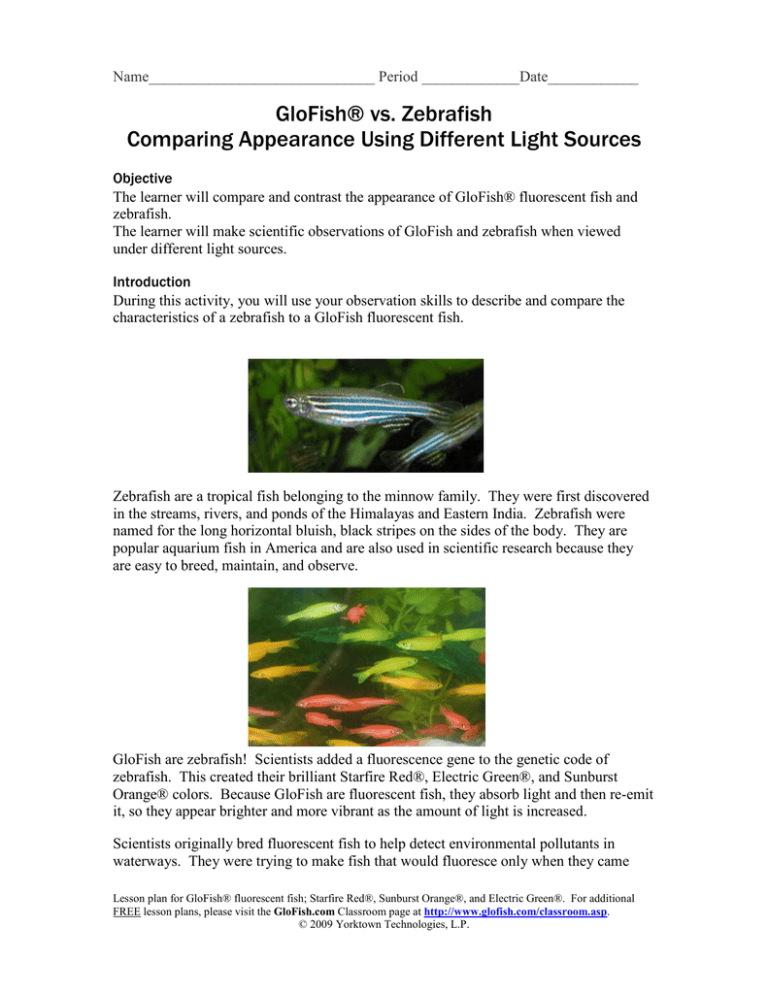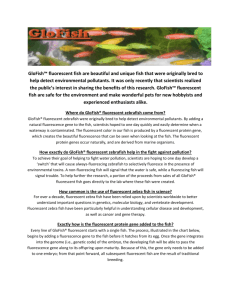GloFish vs Zebrafish
advertisement

Name______________________________ Period _____________Date____________ GloFish® vs. Zebrafish Comparing Appearance Using Different Light Sources Objective The learner will compare and contrast the appearance of GloFish® fluorescent fish and zebrafish. The learner will make scientific observations of GloFish and zebrafish when viewed under different light sources. Introduction During this activity, you will use your observation skills to describe and compare the characteristics of a zebrafish to a GloFish fluorescent fish. Zebrafish are a tropical fish belonging to the minnow family. They were first discovered in the streams, rivers, and ponds of the Himalayas and Eastern India. Zebrafish were named for the long horizontal bluish, black stripes on the sides of the body. They are popular aquarium fish in America and are also used in scientific research because they are easy to breed, maintain, and observe. GloFish are zebrafish! Scientists added a fluorescence gene to the genetic code of zebrafish. This created their brilliant Starfire Red®, Electric Green®, and Sunburst Orange® colors. Because GloFish are fluorescent fish, they absorb light and then re-emit it, so they appear brighter and more vibrant as the amount of light is increased. Scientists originally bred fluorescent fish to help detect environmental pollutants in waterways. They were trying to make fish that would fluoresce only when they came Lesson plan for GloFish® fluorescent fish; Starfire Red®, Sunburst Orange®, and Electric Green®. For additional FREE lesson plans, please visit the GloFish.com Classroom page at http://www.glofish.com/classroom.asp. © 2009 Yorktown Technologies, L.P. into contact with pollutants. The first step was to create a fish that would be fluorescent all the time. This is why the first fluorescent fish were created. National Standards Addressed Science As Inquiry A--Abilities necessary to do scientific inquiry Life Science B—Diversity and adaptations on organisms Life Science C--Characteristics of organisms Life Science C—Structure and function in living systems Materials Per Group 2 clear plastic cocktail cups containing aquarium water Magnifying lens 1 GloFish® 1 Zebrafish Neon florescent markers Black marker Flashlight Halogen light Black light or actinic (blue wavelength) light Safety Precautions Make sure the electrical lighting around water is supervised. Instruct students in the proper ways to handle light sources that are plugged into electrical currents. Demonstrate the proper way to carry or handle the cup containing the fish to avoid accidents. Procedures Part A: Observing Basic Features 1. Place a GloFish in a plastic cup containing aquarium water. 2. Place the cup in a secure, solid surface such as a lab table being careful to not disturb the fish. 3. Obtain a zebrafish in a plastic cup containing aquarium water. 4. Place the cup in a secure, solid surface such as a lab table being careful to not disturb the fish. 5. Use the magnifying lens to carefully observe both fish. Compare the external structures found on the fish. Notice ways the fish are alike and how they are different. 6. Observe the fins, scales, gills, eyes, and color of each fish. Record your observations as descriptions in Data Table 5.1. In your description include how many of each structure are found on the fish. You should also include a description of the shape and location of the structure. Lesson plan for GloFish® fluorescent fish; Starfire Red®, Sunburst Orange®, and Electric Green®. For additional FREE lesson plans, please visit the GloFish.com Classroom page at http://www.glofish.com/classroom.asp. © 2009 Yorktown Technologies, L.P. Part B: Comparing Appearance Using Different Light Sources 1. Turn off your classroom lights and shine the flashlight through the side of the cup and onto the GloFish®. Write a description of the fish’s appearance in the space provided in Data Table 5.1. 2. Shine the flashlight on the Zebrafish. Write a description of the fish’s appearance in the space provided on Data Table 5.1. 3. Repeat steps 1 and 2 using each of the light sources provided. 4. Draw your observations on the data chart and color them with your markers. Data Table 5.1 Observable Part Zebrafish Description GloFish® Description Fins Horizontal Stripes Gills Eyes Color Lesson plan for GloFish® fluorescent fish; Starfire Red®, Sunburst Orange®, and Electric Green®. For additional FREE lesson plans, please visit the GloFish.com Classroom page at http://www.glofish.com/classroom.asp. © 2009 Yorktown Technologies, L.P. Data Table 5.2 Light Source Zebrafish Illustration GloFish® Illustration Flashlight Halogen light Black Light Or Actinic Light Discussion Questions: 1. Did you observe any differences in their fins? 2. Did you observe any differences in their stripes? 3. How many stripes did you count on the zebrafish? How many on the GloFish? 4. Did you observe any differences in their gills? Lesson plan for GloFish® fluorescent fish; Starfire Red®, Sunburst Orange®, and Electric Green®. For additional FREE lesson plans, please visit the GloFish.com Classroom page at http://www.glofish.com/classroom.asp. © 2009 Yorktown Technologies, L.P. 5. Did you observe any differences in their eyes? 6. What is the major difference between zebrafish and GloFish®? 7. Does the light of a flashlight change the appearance of a zebrafish? A GloFish? 8. Does a Halogen light change the appearance of a zebrafish? A GloFish? 9. Does a Black light or Actinic light change the color of a zebrafish? A GloFish? 10. What does increasing light do to a GloFish? Elaborations and Extensions Students research other animals that absorb and re-admit light. Students research the differences between animals that absorb light and those that glow. Lesson plan for GloFish® fluorescent fish; Starfire Red®, Sunburst Orange®, and Electric Green®. For additional FREE lesson plans, please visit the GloFish.com Classroom page at http://www.glofish.com/classroom.asp. © 2009 Yorktown Technologies, L.P. GloFish® vs. Zebrafish Comparing Appearance Using Different Light Sources Answer Sheet Intended Grade Level 4th or 5th Teacher Information Halogen bulbs and black light bulbs can be purchased at local variety stores and home improvement stores. A darkened room will give you better results when using light sources. Students may not have well developed observation and description skills. Encourage skill development by having students practice describing objects to each other as a class activity. Put students in pairs sitting back to back. Give one student in each pair an object to describe to their partner. The partner should not be allowed to look at the object is being described. The one holding the object, such as a test tube, bottle, magnet, etc should describe the object while the second student attempts to draw the object. The student holding the object should never say the name of the object but should use words to give a detailed description. Allow 5 – 7 minutes for the drawing activity. Discuss with the class the importance of making detailed observations. Data Table 5.1 Observable part Fins Zebrafish description Five fins GloFish description Five fins Number of Horizontal Stripes Gills Five stripes Five stripes A pair of gills A pair of gills Eyes Two black eyes Two black eyes Color Black and white stripes Red, green, or orange with stripes Discussion Questions and Possible Answers 1. Did you observe any differences in their fins? No, only in color Lesson plan for GloFish® fluorescent fish; Starfire Red®, Sunburst Orange®, and Electric Green®. For additional FREE lesson plans, please visit the GloFish.com Classroom page at http://www.glofish.com/classroom.asp. © 2009 Yorktown Technologies, L.P. 2. Did you observe any differences in their stripes? Not in number, but the stripes are less noticeable 3. How many stripes did you count on the zebrafish? How many on the GloFish®? Five bluish-black stripes and 4 white stripes on the zebrafish. The GloFish have 4 white stripes which are less distinctive because of their fluorescent colors. 4. Did you observe any differences in their gills? No 5. Did you observe any differences in their eyes? No 6. What is the major difference between zebrafish and GloFish? Their color and brightness of stripes 7. Does the light of a flashlight change the appearance of a zebrafish? A GloFish? Zebrafish – no, GloFish - brightens somewhat, but no 8. Does a Halogen light change the appearance of a zebrafish? A GloFish? Zebrafish - no, GloFish has a uniquely fluorescent look 9. Does a Black light or Actinic light change the color of a zebrafish? A GloFish? Zebrafish - no, the GloFish has a uniquely fluorescent look and appears to be glowing 10. What does increasing light do to a GloFish? Fluorescent fish absorb light and then re-emit it, so they will appear brighter and more vibrant as the amount of light is increased. Lesson plan for GloFish® fluorescent fish; Starfire Red®, Sunburst Orange®, and Electric Green®. For additional FREE lesson plans, please visit the GloFish.com Classroom page at http://www.glofish.com/classroom.asp. © 2009 Yorktown Technologies, L.P.






